8 Natural Deduction
We have effective means to determine, in a finite number of steps, whether an argument formulated in propositional logic is valid. We may, for example, devise a complete truth table for the argument and look for an assignment corresponding to one of the rows of the truth table on which the premises are true and the conclusion is false. If no such assignment is found, then the argument is valid; otherwise, the argument is invalid. The procedure may be overly complex in certain cases, especially when the argument in question happens to involve a high number of propositional variables, but it will nevertheless produce a verdict in a finite number of steps.
Matters are more complicated for quantificational logic. For we are not of course in a position to survey every model for the relevant fragment of the language in order to determine wether or not there is one on which the premises true and the conclusion false. There is an infinite number of them, and there is no effective procedure we can use to survey them all in a finite number of steps. To be sure, if the argument is invalid, we should be able to find a model in which the premises are true and the conclusion is false, but we may not be sure at times whether a temporary failure to find such a model may be due to a lack of imagination rather than to the invalidity of the argument.
Instead, we will develop a natural deduction system for quantificational logic, one which adapts and extends the framework we developed for propositional logic. Once the natural deduction system is in place, we will establish the validity of an argument in the language of quantificational logic by means of a proof of the conclusion from the premises of the argument.
Since quantificational logic includes the usual propositional connectives, we will just import and adapt the introduction and elimination rules we devised for them to the new framework. That is enough to enable us to establish the validity of some arguments in the language of quantificational logic.
Example 8.1
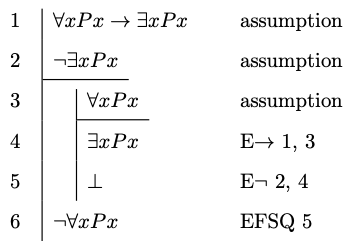
Notice that it suffices in this case to deploy natural deduction rules for negation and the conditional, which we adapt from the natural deduction system for propositional logic.
On the other hand, we are not yet in a position to provide derivations that exploit the behavior of the quantifiers. We require additional natural deduction rules for that purpose.
Universal Quantification
We will introduce introduction and elimination rules for the universal and the existential quantifiers. But in order to even be able to state the rules, we must explain what we mean by an instance of a quantified formula of the form
- Instance
-
If
Example 8.2 Some examples:
We start now with the elimination rule for the universal quantifier.

Universal Elimination
- Universal Elimination
-
You may write an instance
The rationale for universal elimination is that we are entitled to write that an individual
Let us look at the universal elimination rule in action.
Example 8.3
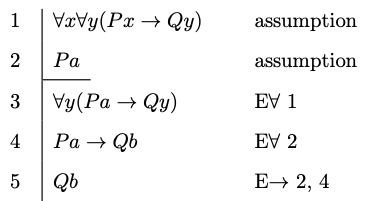
Example 8.4
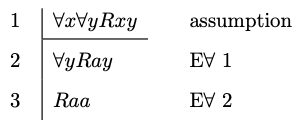
The introduction rule for the universal quantifier requires more care. In order to be able to write

Universal Introduction
- Universal Introduction
-
You may write a universally quantified formula
Let us look at some applications of the rule.
Example 8.5
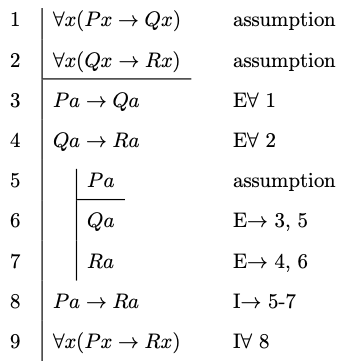
Example 8.6
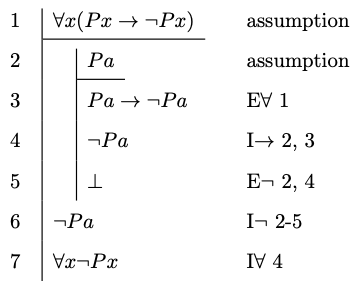
Existential Quantification
We now introduce introduction and elimination rules for the existential quantifier.

Existential Introduction
- Existential Introduction
-
You may write an existentially quantified formula
The rationale for existential introduction is that we are entitled to write that something satisfies a condition if we are given that an individual
Here is the rule of existential introduction in action.
Example 8.7
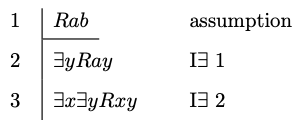
Example 8.8
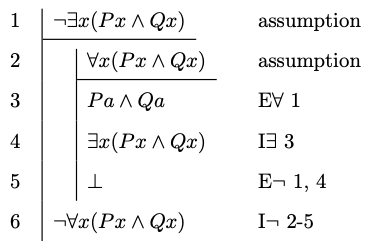
The elimination rule for the existential quantifier is more subtle. Suppose we want to reason from an existential generalization of the form

Existential Elimination
- Existential Elimination
-
You may write
Example 8.9
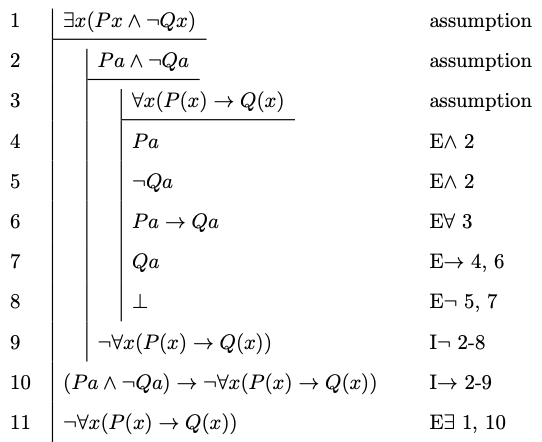
Example 8.10
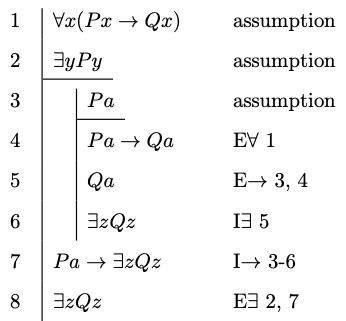
Common Mistakes and Strategies
Much of the advice for the construction of proofs in propositional logic carries over to quantificational logic. In order to prove a universal or existential generalization from a set of premises, it helps to work backwards and with a view to being in a position to use the relevant introduction rule. And to reason forward from a universal or existential generalization, we should use the relevant elimination rules.
One important observation is that the elimination rule for the universal quantifier should not be applied to formulas that are not universally quantified formulas. The rule may be applied, for example, to the universal quantification
One more potential pitfall is the failure to apply the rules for quantification once at a time. The elimination rule for the universal quantifier does not allow an immediate transition from a formula such as
Let us now look at some further examples.
Example 8.11
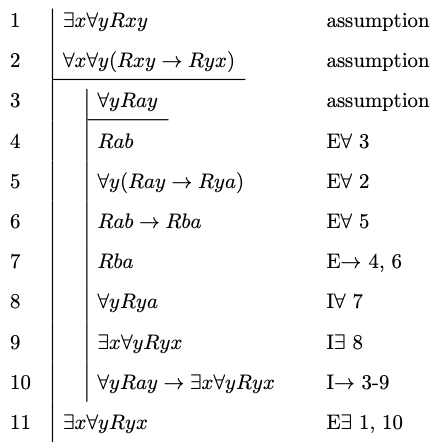
Example 8.12

Exercises
Provide a natural deduction proof in order to justify each of the claims below: